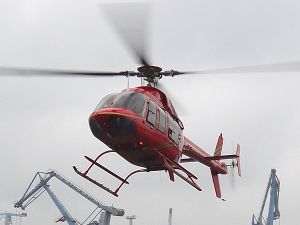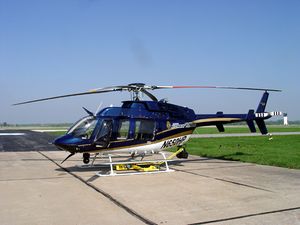PlaneSpottingWorld welcomes all new members! Please gives your ideas at the Terminal.
Bell 407
| Bell 407 | |
|---|---|
| Bell 407 at Airport Niederrhein, Germany | |
| Type | Multipurpose utility helicopter |
| Manufacturer | Bell Helicopter Textron |
| Introduced | 1996 |
| Status | Active service |
| Number built | Over 450 407s delivered by late 2000.[1] |
| Developed from | Model 206L |
| Variants | Bell ARH-70 |
The Bell Model 407 is a civil utility helicopter, a derivative of the Bell 206L-4 LongRanger. The 407 uses a 4-bladed rotor system with a rigid, composite rotor hub instead of the Model 206's 2-bladed conventional rotor. The Bell 407 is frequently used for corporate and offshore transport, as an air ambulance, law enforcement, electronic news gathering and movie making.
Contents
Development
In 1993, Bell's began to development the New Light Aircraft as a replacement for its Model 206 series. The program resulted in the 407, an evolutionary development of the Bell 206L-4 LongRanger.[1]
A 206L-3 LongRanger was converted as the concept demonstrator 407 and first flew in this form on April 21, 1994, while the 407 was first publicly announced at the Las Vegas Heli-Expo in January 1995.[1] The first pre-production 407 flew in June 1995, and the first production 407 flew in November 1995. Customer deliveries began the following February.
The Bell 407 features the four blade main rotor developed for the OH-58 (Model 406). The blades and hub use composite construction, have no life limits, and provide improved performance and better ride comfort.[1]
The 407's cabin is also 18cm (8in) wider cabin, increasing internal cabin width and space, and features 35% larger main cabin windows. The more powerful Rolls-Royce (Allison) 250-C47 turboshaft allows an increase in max takeoff weight and improves performance at hotter temperatures and/or higher altitudes. In 1995, Bell studied fitting the 407 with a shrouded tail rotor, but did not proceed.[1]
For a time, Bell studied developing the Model 407T twin, but instead chose to develop the essentially all new twin PW206D powered Bell 427.[1]
ARH-70/Bell 417
The ARH-70 armed reconnaissance helicopter, is being developed for the U.S. Army is based the 407.

The Bell 417 was a growth variant of the Bell 407, in essence a civil version of the ARH-70 armed reconnaissance helicopter for the US Army. The 417 made its first flight on June 8, 2006.[2] The 417 was to be powered by a Honeywell HTS900 turboshaft engine, producing 970 shp and includes full FADEC controls. The cabin will seat 5 passengers in club-seating configuration, in addition to the crew of two.[3] The civilian 417 was canceled at Heli-Expo 2007 in Orlando,[4] but the ARH-70 will continue production.[5]
Operational history
Polar First
Polar First was an around-the-world, pole-to-pole record flight flown by Colin Bodill and Jennifer Murray utilizing a standard Bell 407. The flight originated from Bell's facility at the Fort Worth Alliance Airport on December 5, 2006 and was completed upon the return of the helicopter to the same facility on May 23, 2007. The team flew about Template:Convert over 189 days and 300 flight hours, through 34 different countries. The flight was performed in partnership with the Royal Geographical Society to provide educational outreach to 28 international schools, which were visited during the trip. The project also served as a fundraiser for the SOS Children's Villages.[6]
Variants
- Bell 407
- A civil utility helicopter, a derivative of the Bell 206L-4.
- ARH-70
- An upgraded 407 version to serve as an armed reconnaissance helicopter.
- Bell 417
- Planned civil version of the ARH-70, was canceled.
Operators
Specifications (Bell 407)
Data from Bell 407[7]
General characteristics
- Crew: 1 pilot
- Capacity: Typical seating configuration for seven comprising pilot and passengers, with five passengers in main cabin. Max hook capacity 1200 kg (2645 lb).[1]
- Length: 41 ft 8 in (12.7 m)
- Rotor diameter: 35 ft 0 in (10.67 m)
- Height: 11 ft 8 in (3.56 m)
- Disc area: 962 ft² (89 m²)
- Empty weight: 2668 lb (1210 kg)
- Useful load: 2347 lb (internal) (1065 kg (internal))
- Max takeoff weight: 6,000 lb (2,722 kg)
- Powerplant: 1× Allison 250-C47 turboshaft, 700 shp (520 kW)
- Propellers: 4 blade rotor
Performance
- Maximum speed: 140 knots (260 km/h)
- Cruise speed: 133 knots (246 km/h)
- Range: 330 mi (612 km)
- Service ceiling: 18,690 ft (5,698 m)
References
- ↑ 1.0 1.1 1.2 1.3 1.4 1.5 1.6 Frawley, Gerard: The International Directiory of Civil Aircraft, 2003-2004, page 47. Aerospace Publications Pty Ltd, 2003. ISBN 1-875671-58-7
- ↑ (October 2006) "Bell 417 achieves first flight". Rotorbreeze 55 (3): 12.
- ↑ Bell Helicopter Unveils New Bell 417. Retrieved on 2006-11-09.
- ↑ Bell Scraps Year-Old 417, Finding No Market. Retrieved on 2007-06-03.
- ↑ A Bit of Patton?. Retrieved on 2007-06-03.
- ↑ "Poloar First Sets World Record", Rotorbreeze Magazine, July 2007.
- ↑ Bell 407 specifications
External links
Related content
Related development
Comparable aircraft
Related lists
Fighter aircraft: YFM-1 · P-39 · P-59 · P-63 · XP-77 · XP-83
Commercial Helicopters: 47 · 204 · 205 · 206 · 210 · 212 · 214 · 222 · 230 · 407 · 412 · 417 · 427 · 429 · 430
Military Helicopters: H-13 · UH-1 · 207 · 209 · AH-1 · 309 · YAH-63 · OH-58 · ARH-70
Tiltrotors: V-22 · BA609 · TR918 · QTR
Experimental aircraft: X-1 · X-2 · X-5 · X-20 X-22 · XV-3 · XV-15 · 533 ·
Lists relating to aviation | |
|---|---|
| General | Timeline of aviation · Aircraft · Aircraft manufacturers · Aircraft engines · Aircraft engine manufacturers · Airports · Airlines |
| Military | Air forces · Aircraft weapons · Missiles · Unmanned aerial vehicles (UAVs) · Experimental aircraft |
| Notable incidents and accidents | Military aviation · Airliners · General aviation · Famous aviation-related deaths |
| Records | Flight airspeed record · Flight distance record · Flight altitude record · Flight endurance record · Most produced aircraft |


